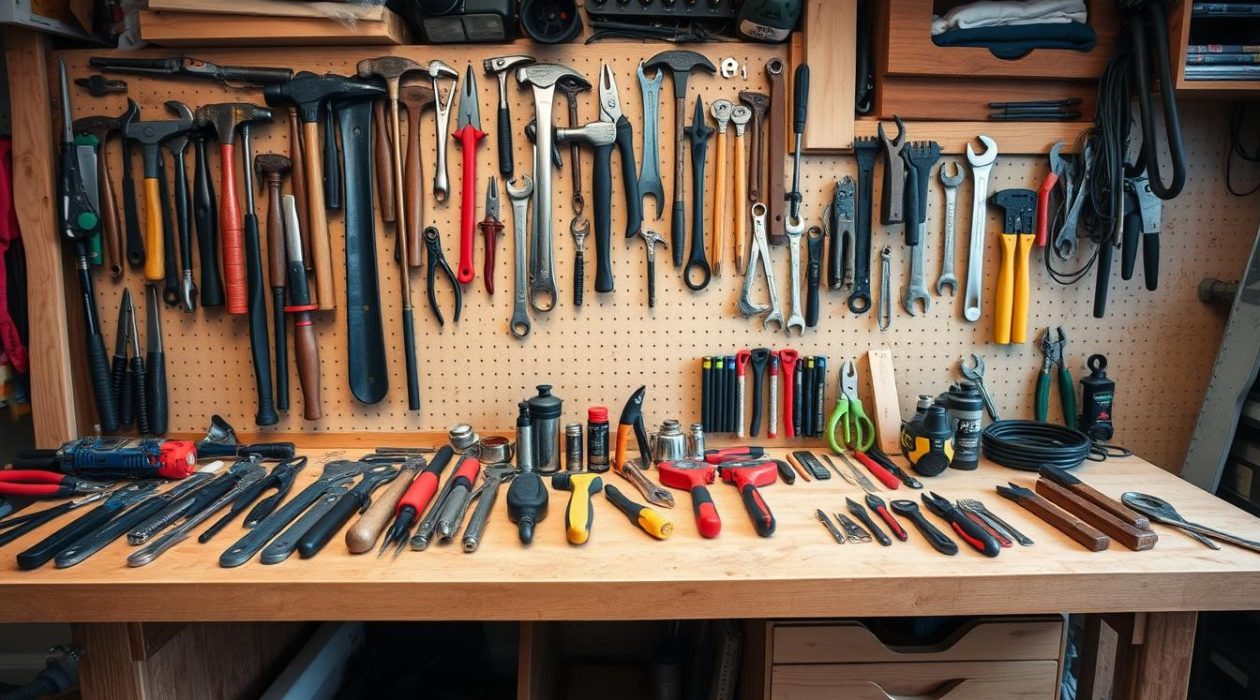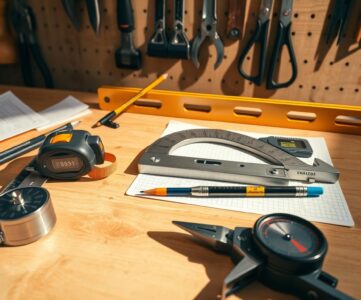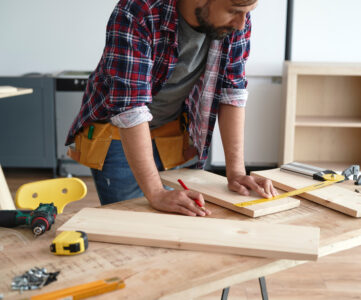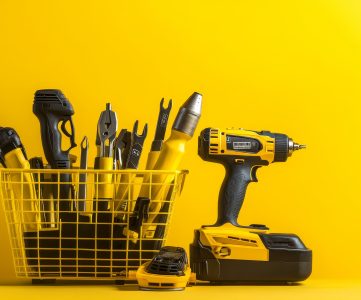When diving into DIY projects, picking the right hand tools is key to success. With so many options, it can be daunting, even for beginners. To simplify the choice, think about the projects you’ll be doing and how often you’ll use each tool. This will help you narrow down your selection.
Choosing the correct hand tools saves you time and money in the long haul. By picking tools that meet your needs, you’ll work more efficiently and effectively. Whether you’re an experienced DIYer or just starting, the right tools are vital for top-notch results.
Key Takeaways
- Choosing the right hand tools is crucial for the success of your DIY projects
- Selecting hand tools that fit your needs will save you time and money
- Consider the types of projects you plan to undertake when selecting hand tools
- Frequency of use is an important factor in choosing DIY tools
- Understanding the importance of selecting hand tools will help you achieve professional-looking results
- Start by selecting basic hand tools and gradually add more to your collection
- Research and compare different hand tools to find the best fit for your needs
Essential Hand Tools Every DIY Enthusiast Needs
For DIY projects, the right hand tools are key to success. The best tools can significantly impact the accuracy, efficiency, and safety of your work. Start by stocking your toolbox with basic tools for measuring, cutting, and striking.
A good toolbox includes measuring tapes, levels, and pencils for precise measurements and markings. These tools are vital for ensuring your projects are accurate and level. For cutting and shaping, saws, drills, and sanders are essential. They allow you to work with various materials and achieve the desired shape and finish.
Basic Measuring and Marking Tools
- Tape measures
- Levels
- Pencils
Cutting and Shaping Tools
- Saws
- Drills
- Sanders
Striking and Hammering Tools
- Hammers
- Mallets
Investing in the best DIY tools gives you confidence and precision in tackling various tasks. Choose tools that are durable, reliable, and meet your specific needs. With the right tools, you’ll become a skilled DIY enthusiast.
Understanding Tool Quality and Materials
Quality and materials are crucial in hand tools’ performance and longevity. A reliable tool buying guide explains the distinctions between materials like stainless steel, titanium, and wood. These differences significantly affect the tool’s quality. While premium tools may seem pricey, they offer long-term savings through their durability and superior performance.
Assessing tool quality involves examining the handle material, ergonomics, and the steel type. A tool with a well-designed handle reduces fatigue and enhances precision. A detailed tool buying guide also teaches how to evaluate tools for quality. This includes spotting wear or damage before purchase.
Investing in high-quality tools brings several advantages:
- Longer lifespan: High-quality tools endure longer, minimizing replacement needs.
- Improved performance: Crafted with precision, these tools streamline tasks.
- Cost savings: Though pricier initially, they save money by avoiding frequent repairs or replacements.
By weighing these factors and researching, you can make wise hand tool purchases. This approach helps you find the most suitable tool buying guide for your needs.
| Tool Material | Benefits | Drawbacks |
|---|---|---|
| Stainless Steel | Durable, resistant to corrosion | Can be heavy, expensive |
| Titanium | Lightweight, strong, corrosion-resistant | Expensive, may not be suitable for all applications |
| Wood | Comfortable, ergonomic, affordable | May not be as durable as other materials, can be prone to wear and tear |
Assessing Your Project Requirements Before Tool Shopping
When selecting hand tools and DIY tools, it’s crucial to evaluate your project needs first. You must identify the project’s scope, consider your budget, and analyze tool usage frequency. This approach helps you focus on essential purchases, ensuring you’re ready for your task.
For example, in woodworking, you’ll need specific cutting and shaping tools. This might include a table saw, miter saw, or drill press. In contrast, plumbing projects require tools like pipe wrenches, pliers, and tubing cutters.
- Project scope: What is the nature of your project, and what tools will you need to complete it?
- Budget: How much are you willing to spend on tools, and what are your priorities?
- Frequency of use: How often will you be using each tool, and which ones will you need to use most frequently?
By carefully evaluating these factors and choosing tools that meet your project and budget needs, you’ll efficiently complete your project. Always prioritize quality and safety when selecting tools. If unsure, don’t hesitate to seek professional advice on tool selection.
| Tool Type | Project Scope | Budget | Frequency of Use |
|---|---|---|---|
| Cutting and Shaping Tools | Woodworking | $100-$500 | High |
| Pipe Wrenches and Pliers | Plumbing | $50-$200 | Medium |
| Drill Press and Bits | Woodworking and Metalworking | $200-$1000 | High |
Professional vs DIY-Grade Hand Tools: Making the Right Choice
Choosing the right hand tools for DIY projects requires considering your skill level and how often you’ll use them. Professional-grade tools are known for their durability and precision but are pricier. In contrast, DIY-grade tools are more budget-friendly and perfect for occasional use. A tool buying guide can guide you in picking the best tools for DIY projects, balancing quality and affordability.
When deciding, think about these key points:
- Project scope: What projects will you tackle, and what tools will you need?
- Frequency of use: How often will you use the tools, and do they need to last long?
- Budget: What’s your tool budget, and are you ready to invest in quality for frequent use?
A tool buying guide offers insights and suggestions for the right DIY tools. By weighing your needs and budget, you can pick the best tools for DIY projects. This ensures your projects are successful and well-executed.
Safety Features to Look for in Hand Tools
When choosing hand tools, safety must be your primary concern. Opting for DIY tools that prioritize safety can prevent injuries and ensure a secure workspace. Ergonomic design is crucial, as it reduces fatigue and enhances grip, lowering accident risks.
Key safety features to look for in hand tools include:
- Ergonomic handles that fit comfortably in the hand
- Non-slip grips to prevent tools from slipping out of the hand
- Protective guards or shields to prevent injury from sharp edges or points
It’s vital to ensure tools meet material safety standards, as set by regulatory bodies. Understanding how to use each tool correctly is also essential. By focusing on these aspects when picking hand tools, you can create a safe and efficient workspace.
For instance, selecting hand tools with ergonomic design can lower injury risks and boost productivity. Also, choosing DIY tools that adhere to safety standards can offer reassurance and prevent accidents.
By prioritizing safety and thoroughly researching each tool’s features and guidelines, you can ensure a safe and productive workspace. This approach will help prevent injuries and guarantee a successful DIY endeavor.
| Tool Type | Safety Feature | Importance |
|---|---|---|
| Hammer | Non-slip grip | High |
| Saw | Protective guard | High |
| Pliers | Ergonomic handle | Medium |
Where to Buy Quality Hand Tools
When you’re in the market for hand tools, a tool buying guide is crucial. It helps you choose the best brands and retailers, both online and offline. This ensures you’re investing wisely.
Home improvement stores like Home Depot and Lowe’s are great places to start. Online retailers such as Amazon are also excellent options. Remember to check the warranty, customer service, and return policies. Buying from a trusted source guarantees durable tools, enhancing your tool buying experience.
Specialty stores, like those focused on woodworking or automotive tools, are worth exploring. Their staff often has in-depth knowledge, offering valuable advice. By researching and comparing options, you can confidently purchase quality hand tools and begin building your collection.
Maintaining and Caring for Your Tool Collection
To maximize the value of your DIY tools, proper maintenance is key. Ensure your tools are clean and stored in a dry, shaded area. Regular cleaning helps prevent damage and extends tool lifespan.
Implementing rust prevention strategies, like applying protective coatings or storing tools in dry conditions, is crucial. Knowing when to replace tools is also vital. Using worn-out tools can be hazardous and compromise your work’s quality.
Cleaning and Storage Tips
- Store tools in a dry, well-ventilated area
- Clean tools regularly to prevent rust and corrosion
- Use a soft cloth to wipe down tools and prevent scratching
Adopting these maintenance practices ensures your tools remain in top condition. This approach not only saves you money but also enhances your DIY projects’ quality.
Rust Prevention Methods
Preventing rust is essential for tool longevity. Applying rust-inhibiting coatings or storing tools in dry environments can significantly reduce rust and corrosion. Silica gel packets or desiccants can also absorb moisture, preventing rust.
Building Your Tool Collection Gradually
When selecting hand tools and choosing DIY tools, focus on long-term benefits. Building a comprehensive tool collection doesn’t have to be expensive or happen quickly. Start with the basics and gradually add more tools to ensure you’re ready for any DIY project.
Identify versatile tools that work across various projects. This strategy helps grow your collection smartly, avoiding unnecessary duplication and waste. Think about future projects and pick tools that fit multiple needs.
Starting with the Basics
A solid foundation of basic tools is essential for any DIY enthusiast. This includes hammers, screwdrivers, pliers, and tape measures. Look for high-quality materials and ergonomic designs for comfort during extended use.
Expanding Your Arsenal
As your DIY skills improve, expand your tool collection with specialized items. This might include power tools like drills or saws, or advanced hand tools like wrenches or socket sets. Choose tools that meet your project’s specific needs, enhancing efficiency and ease.
Building your tool collection gradually ensures you’re always ready for DIY projects. Prioritize versatility, quality, and comfort when selecting tools. Investing in the right tools makes projects easier and more enjoyable.
| Tool Type | Description | Uses |
|---|---|---|
| Hammer | Basic striking tool | Framing, finishing, demolition |
| Tape Measure | Flexible measuring tool | Measuring rooms, materials, and projects |
| Pliers | Gripping and bending tool | Electrical, plumbing, and carpentry work |
Making Smart Tool Investments for Long-Term DIY Success
Choosing the right hand tools for DIY projects is a long-term investment. It can significantly enhance your hobby or profession. By understanding your needs and selecting high-quality tools, you ensure long-term success. A detailed tool buying guide is essential for making informed decisions.
The best tools for DIY projects offer a balance of quality, functionality, and cost. They provide reliable service for years, helping you achieve professional-looking results. With the right tools, you’ll confidently tackle any home improvement or craft project.






